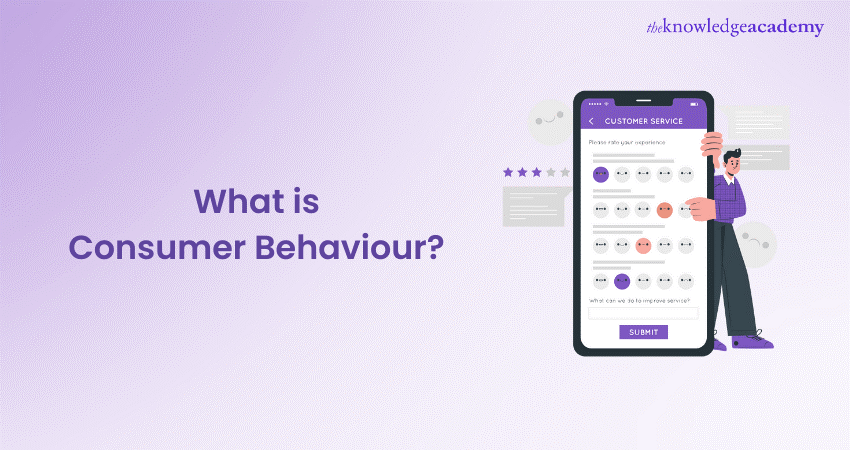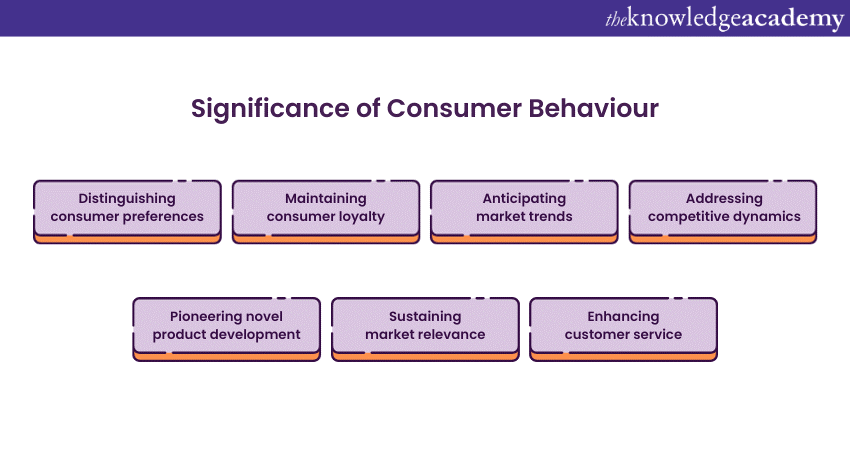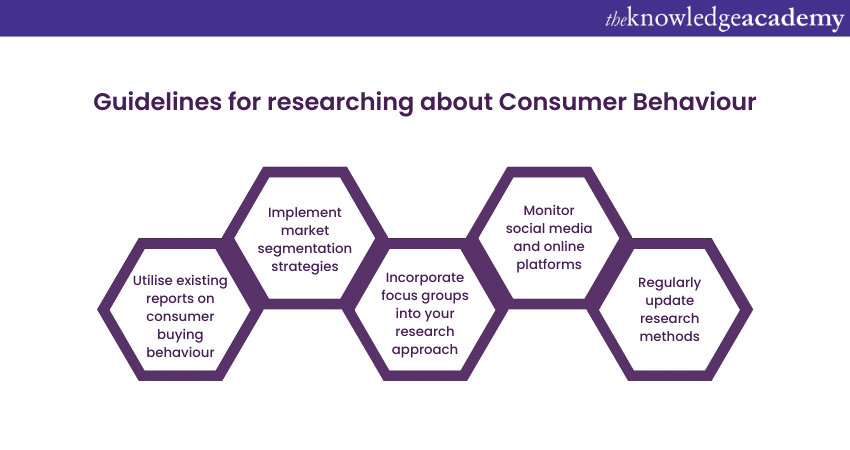We may not have the course you’re looking for. If you enquire or give us a call on 01344203999 and speak to our training experts, we may still be able to help with your training requirements.
Training Outcomes Within Your Budget!
We ensure quality, budget-alignment, and timely delivery by our expert instructors.

Have you ever thought about why we choose certain products or brands? If yes, then it is important to understand What is Consumer Behaviour and its significance when it comes to consumer decision-making. From the impact of culture to our individual preferences, Consumer Behaviour is the key to decoding the whys behind our purchasing decisions. Uncover the answer to "What is Consumer Behaviour?" and delve into the fascinating psychology behind why we choose the products we do.
Table of Contents
1) What is Consumer Behaviour?
2) Types of Consumer Behaviour
3) Significance of Consumer Behaviour
4) Guidelines for researching about Consumer Behaviour
5) Conclusion
What is Consumer Behaviour?
Consumer Behaviour examines the ways in which individuals, groups, or organisations make decisions about choosing, purchasing, utilising, and discarding goods, services, or experiences to fulfil their desires and requirements. This field covers various actions, starting from the initial acknowledgment of a need or desire to the ultimate disposal of the item. Grasping Consumer Behaviour is essential for companies to craft successful marketing strategies and to design products and services that align with consumer preferences.
Various factors influence Consumer Behaviour, including cultural, social, personal, and psychological factors. Cultural factors involve a person's culture, subculture, and social class, while social factors include reference groups, family, and social roles. Personal factors encompass age, occupation, lifestyle, and personality, while psychological factors involve motivation, perception, learning, and attitudes.
Consider a scenario where a customer is in the market for a new smartphone. The Consumer Behaviour journey begins with the recognition of a need—perhaps a desire for advanced features or a better camera. External factors, such as positive online reviews, play a crucial role in the information-gathering stage. Ultimately, the purchasing decision is made, and the chosen smartphone is brought into the consumer's life.
Types of Consumer Behaviour
Consumer Behaviour can be categorised into several types based on various factors. Here are four key types of Consumer Behaviour:
1) Habitual purchasing behaviour
Habitual purchasing behaviour unfolds when consumers make routine purchases with minimal contemplation. This occurs as part of their everyday routine, where decisions are often driven by factors such as convenience, brand loyalty, and price. Marketers targeting this behaviour focus on repetitive, visually impactful advertisements and promotions to enhance brand familiarity and attract first-time buyers through discounts.
2) Variety-seeking purchasing behaviour
Variety-seeking purchasing behaviour is characterised by consumers actively seeking new products and experiences. In this scenario, individuals enjoy experimenting with different brands and products, driven by the desire for variety. Marketers tailor strategies to attract these consumers by emphasising innovation, differentiation, and promoting the unique features of their products.
3) Complex purchasing behaviour
Complex purchasing behaviour involves in-depth decision-making and research, typically associated with significant purchases. Consumers engaging in complex behaviour carefully evaluate options, gather extensive information, and weigh various factors before deciding. Businesses targeting complex purchasers focus on providing detailed information, building trust, and delivering a seamless buying experience.
4) Dissonance-reducing purchasing behaviour
Dissonance-reducing purchasing behaviour arises when consumers experience post-purchase doubts or anxiety. This commonly happens when there are multiple appealing alternatives, making the decision-making process challenging. To alleviate this cognitive dissonance, consumers seek additional information or reassurance after the purchase. Businesses address this behaviour through effective communication, customer support, and follow-up initiatives to reduce buyer's remorse and enhance confidence in their decision.
Enhance your marketing prowess with our Marketing Research Masterclass and elevate your strategic skills for business success!
Significance of Consumer Behaviour
Let’s discuss the significance of Consumer Behaviour.

1) Distinguishing consumer preferences
When businesses understand consumer preferences, they uncover what customers like and dislike when purchasing. This insight is similar to discovering the recipe for success in the marketplace.
For instance, if a company discerns customers prefer eco-friendly products, they can adjust their offerings accordingly. This might involve creating items with minimal environmental impact, aligning with the eco-conscious trend. Beyond the product, businesses can tailor their marketing strategies to emphasise these environmentally friendly aspects.
2) Maintaining consumer loyalty
Maintaining consumer loyalty is the art of building enduring relationships between customers and brands. It resembles having a reliable go-to brand or shop, where businesses strive to create an experience that consistently attracts customers. This involves a deep understanding of customer preferences and expectations, achieved through feedback analysis and studying purchasing behaviours.
Brands actively listen to customer feedback, aiming to enhance products and services continually. The goal is to deliver consistency in quality, value, and positive experiences, fostering trust.
3) Anticipating market trends
This is like predicting what's going to be popular in the future. By understanding what people are starting to like or want, businesses can prepare and offer products or services that meet these emerging trends.
It's about staying ahead in the world of shopping and providing what customers will soon be looking for. This strategic foresight not only enhances a company's competitiveness but also ensures it remains a trailblazer in meeting the dynamic expectations of the market.
4) Addressing competitive dynamics
Addressing competitive dynamics involves a strategic understanding of how consumers make choices among various brands or products in the market. It's like peering into the consumer's decision-making process and deciphering the factors that influence their preferences. When businesses grasp these dynamics, they gain a competitive edge by positioning their products or services more effectively.
This understanding allows companies to identify and highlight the unique features or qualities that set their offerings apart from the competition. It's not just about having a product; it's about showcasing why that product is the best choice. This could be based on quality, price, innovation, or a combination of factors that resonate with the target audience.
Transform your marketing brilliance with our Integrated Marketing Masterclass. Sign up now!
5) Pioneering novel product development
Pioneering novel product development is like being a trendsetter in the world of innovation. It involves using insights gained from understanding Consumer Behaviour to create fresh and appealing products that meet unmet needs or desires. This process begins by keenly observing consumer preferences and identifying gaps in the market—areas where existing products might not fully satisfy consumer demands.
Businesses delve into the intricacies of Consumer Behaviour, seeking to uncover latent desires or areas where improvements can be made. This thorough understanding allows companies to generate inventive ideas that resonate with consumers' wants but have yet to find in the market.
6) Sustaining market relevance
Sustaining market relevance is a continual effort by businesses to stay relevant in the ever-evolving marketplace. It's akin to staying in tune with the latest tunes in a dynamic industry orchestra. To achieve this, companies vigilantly monitor how consumer preferences shift over time. This involves observing and actively engaging with changing trends, preferences, and expectations.
7) Enhancing customer service
Understanding how customers behave is the foundation of exceptional service. Businesses gain valuable insights by actively listening to customer feedback and studying their preferences. This knowledge allows companies to customise their services, ensuring they align precisely with customers' likes and dislikes. It's a personalised approach that transcends a one-size-fits-all mentality.
Tailoring services to meet customer needs is a proactive effort. Whether it's adjusting communication styles, refining products, or streamlining processes, this adaptability ensures that customers not only get what they want but also feel heard and valued.
Supercharge your marketing expertise with our Introduction to Marketing Training – Sign up today and propel your career forward!
Guidelines for researching about Consumer Behaviour
Listed below are some of the guidelines for conducting research on Consumer Behaviour.

1) Utilise existing reports on consumer buying behaviour
Leveraging existing reports provides a valuable starting point for understanding Consumer Behaviour. Analyse market research studies, industry reports, and consumer surveys. These sources can offer insights into trends, preferences, and buying patterns. It's like tapping into a wealth of knowledge that others have already gathered, giving your research a solid foundation and helping you identify areas for further investigation.
2) Implement market segmentation strategies
Market segmentation divides a larger market into distinct groups based on similar characteristics or behaviours. By employing segmentation strategies, researchers can gain a more nuanced understanding of Consumer Behaviour within specific demographics or interest categories. This approach allows for targeted analysis, helping businesses iterate their products and marketing strategies to meet the unique needs of each segment.
3) Incorporate focus groups into your research approach
Engaging with focus groups provides a qualitative dimension to Consumer Behaviour research. These small, interactive gatherings of potential customers allow for in-depth discussions. By facilitating conversations, researchers can uncover detailed insights into attitudes, perceptions, and motivations.
It's like having a direct conversation with the target audience, providing a deeper understanding of the emotional and psychological aspects that influence consumer choices. Focus groups complement quantitative data, offering a more comprehensive view of Consumer Behaviour.
Conclusion
By understanding what makes customers tick and what triggers their buying decisions, companies can cook up new products and marketing magic to rake in profits. But here's the catch: to really nail it, companies need to have a chat with customers, keep an eye out for their bugbears, and, above all, figure out what they want and expect. So, in a nutshell, what is Consumer Behaviour? It's the compass guiding businesses to create stuff people love, ensuring a happy, loyal bunch of customers.
Elevate your marketing skills with our comprehensive Marketing Courses – Join now for a strategic leap in your marketing career!
Frequently Asked Questions
Upcoming Digital Marketing Resources Batches & Dates
Date
 Consumer Behaviour Course
Consumer Behaviour Course
Fri 24th May 2024
Fri 28th Jun 2024
Fri 26th Jul 2024
Fri 9th Aug 2024
Fri 6th Sep 2024
Fri 18th Oct 2024
Fri 8th Nov 2024
Fri 13th Dec 2024







 Top Rated Course
Top Rated Course



 If you wish to make any changes to your course, please
If you wish to make any changes to your course, please


